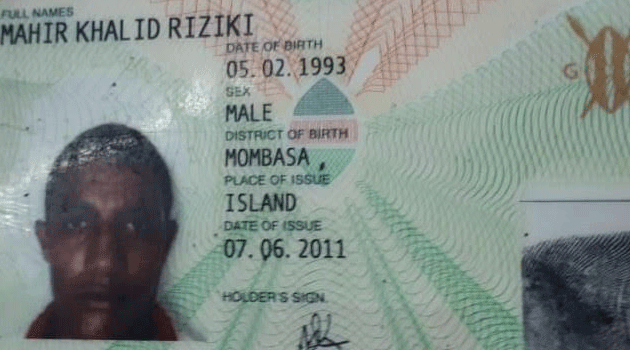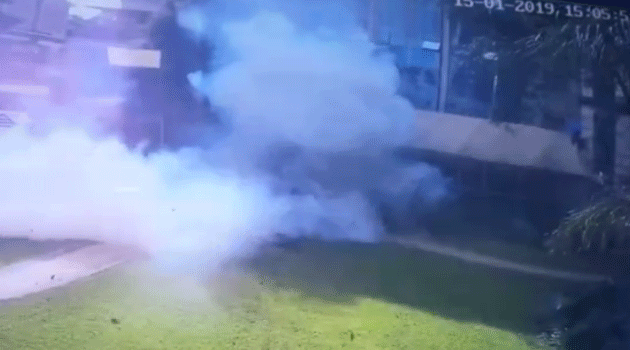
Mahir Khalid Riziki, the suicide Bomber at the Dusit D2 attack was apparently part of the armed terrorists that raided the Garissa Univeristy back in 2015 and killed 147 students.
In April 2015, hours after the end of the siege, the police released the name of Mahir Khalid Riziki alongside eight others, labelling them “most wanted”.
Besides Riziki, others listed were Ismael Shosi Mohamed aka Ismael Mmanga, Abdulkarim Mzee aka Abdul, Farah Abdi Farah, Kayuni Khatib Khamisi, Fauz Omar Mohamed, Swaleh Ramadhan, Suleiman Mohamed Awadh, Abdalla Salim Marumu, Abdifataha Abubakar Abdi aka Musa Muhajir (a Somali citizen), Mohamed Abubakar Mohamed and Muumin Abdalla Muumin.
Kayuni, Saraj aka Abdul and Ramadhan surrendered themselves to the police as early as November 2014.
Both Fauz Omar Mohamed and Farah Abdi Farah were kidnapped by unknown people never to be seen again.
Human rights activists blame security agents for their disappearance.
In bloody confrontations, security agents gunned down Mr Shosi aka Ismael Mmanga, Mr Awadh and Mr Marumu.
Almost everyone in that list either disappeared mysteriously, was arrested or killed except for two suspects – Abdifataha Abubakar Abdi aka Musa Muhajir and Mahir Khalid Riziki.

Whereas, in March 2018, Muhajir was included by the US in the list of global terrorists, Riziki’s name never featured on any most wanted terror lists since 2016.
One of the arguments put forward by the detectives investigating the Tuesday attacks is that terrorists have become better at covert communications.
But, information obtained after the arrest of Suhaila Mwalim Bakari is that she communicated with her husband on mobile phone as early as this year.
Authorities say that the suicide bomber was a member of Jaysh Al Ayman, an elite of Al-Shabaab, notoriously connected to the foiled Baure attack on the Kenya Defence Forces in 2015 and the Mpeketoni attack a year earlier.
Regional body Igad says that Jaysh Ayman was formed in late 2013 by then-Al-Shabaab leader Ahmed Abdi Godane as an elite unit specially formed to conduct attacks in Kenya.
Riziki joined the terror group after being radicalised at the Masjid Musa mosque in the notorious Majengo neighbourhood in Mombasa, after being influenced by Sheikh Iman Ali, the Kenyan Al-Shabaab commander who masterminded the El Adde attack in 2015.
The 25-year-old jihadist joined the group after dropping out in form one at Bhadala Secondary School in Mombasa in 2011.
He later got married to Ms Bakari in 2012. Riziki would then operate a tuk tuk for some time before fully joining the radical group at Masjid Musa mosque from where he was recruited.
It’s here that he met Ramadhan Hamisi Kufungwa, another recruit of Sheikh Iman Ali whose video following the El Adde attack went viral.

For sometime, Riziki operated in the Jaysh Al Ayman cell based in Boni Forest before crossing over to Somalia to join the Al-Shabaab between 2013 and 2014.
In mid-2014, Riziki came to the radar of the police after he escaped a police raid at Masjid Musa in Majengo together with his associate, only identified by his nickname Rambo.
“The two were involved in the attack of a police officer at Royal Court in Mombasa,” said a police source. Rambo’s whereabouts remain unknown to date.
Security agents say that Riziki suffered bullet wounds on the leg during the escape and was admitted to a Mombasa hospital before his accomplices managed to smuggle him out of the facility. He later fled to neighbouring Tanzania.
Police believe that he travelled for jihadism in Yemen from Tanzania only to resurface after his photo was released by the police in 2015 following the Garissa University attacks.
He was never to be seen until last week when he was captured on video detonating his suicide vest at 14 Riverside Drive.